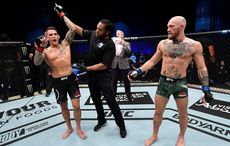The New England Patriots, to nobody's surprise, enter the NFL draft this weekend with multiple draft picks in the first round. With regards to the New Orleans Saints, after they traded their first round selection this year to draft Mark Ingram last year, the Patriots highest draft pick comes at number 27 overall.
Bill Belichick and company are well used to picking at the end of each round as they are consistently competing in the playoffs. While each year's draft is unique, there is a certain level of consistency that can generally be found if you trace the history of each draft pick from season to season.
As such, let's take a look at the last 10 27th overall picks in the NFL draft.
2011—The Baltimore Ravens select Jimmy Smith.
It is way too early to judge Smith, however at the time of drafting Smith was considered one of the elite talents in the draft who fell because of off-the-field issues and his attitude. At the bottom of round one, those kind of players are often taken.
2010—The New England Patriots select Devin McCourty.
It didn't take us long to come across a Patriots' trade. In 2010 the Patriots traded back from 24th overall with the Dallas Cowboys to select McCourty at 27th. McCourty was the third cornerback off the board.
After a solid rookie season, McCourty severely struggled in his second second season. It's still very early to judge McCourty but the Patriots undoubtedly were able to get a talented player at the back end of the first round round.
2009—The Indianapolis Colts select Donald Brown.
In 2009, Donald Brown was only the second running back to come off the board after Knowshon Moreno went to the Denver Broncos early on. Brown had been an underwhelming performer prior to this past season when he gave the offense in Indianapolis some life to avoid going winless.
While the Patriots do not need a running back, this pick does show the team that they will have an opportunity to draft a top tier player at one of the 'lesser' positions despite picking late in the round.
2008—The San Diego Chargers select Antoine Cason.
Once again, in the form of Cason, the third choice cornerback came off the board in 2008 at the 27th pick. Much like McCourty, Cason has proven to have a huge amount of talent but struggle with his consistency throughout his career.
This pick reimburses the idea that you can get a talented player who needs to be coached at the end of round one. Each of Jimmy Smith, McCourty and Cason have their flaws, but each also has the potential to be All-Pro players if certain things go their way.
2007—The New Orleans Saints select Robert Meachem.
The 2007 draft saw a very strong and deep group of receivers enter the NFL. Meachem was the fourth of six receivers to go in the first round. Quite often, teams picking this late in the first round will simply take the best player available rather than adding a player to fill a need.
This pick perfectly portrays this ideal.
2006—The Carolina Panthers select DeAngelo Williams.
Another third overall prospect went 27th in 2006. Even though Reggie Bush and Laurence Maroney went higher than Williams, Williams has easily been the better running back throughout his career. At the very least, he has been a lot more productive than the other two.
Often teams will bring in running backs, guards, safeties or defensive ends at this stage of the draft as those positions, more often than not, offer more depth and talent than others.
2005—The Atlanta Falcons select Roddy White.
The best wide receiver in the entire class found his way to the Falcons at pick number 27 in 2005. White has proven himself to be an all-pro caliber player with some of the most consistent hands in football.
If the 2005 draft was redone today, White would be a lot closer to the top and easily be the number one receiver taken.
2004—The Houston Texans select Jason Babin.
Jason Babin may be a Pro Bowler, but he is also exactly the type of player that the Patriots will be expecting to draft this year, someone who needs coaching or has flaws that need to be hidden. Babin receives a lot of fame for his sack numbers but he doesn't play the run well at all and is a scheme specific player.
There is nothing wrong with being a scheme specific player, in fact it can allow you to add greater talent than you would normally expect to get at this point in the draft, however said player is limited and must be kept in that scheme to remain as productive as possible.
2003—The Kansas City Chiefs select Larry Johnson.
Every offensive selection at number 27 in the past decade has been a skill position player. This reflects the best player available attitude which often sees running backs and wide receivers leading the way at the top. Johnson was a devastating runner in Kansas City before leaving once the tires fell off and his attitude went with it.
Johnson was the second back off the board with the first only going 23rd overall—Willis McGahee to the Buffalo Bills.
2002—The San Francisco 49ers select Mike Rumph.
Rumph, a cornerback, more than any other draft pick shows just how close teams are to picking up a scrub when they are outside the top 20. Rumph never really made any impact in the NFL and was gone completely after the 2006 season having started only 19 career games.
In a weaker draft, the 27th pick is not going to be high enough to guarantee you even a contributor.
The last 10 draft picks at 27 in the first round is certainly a mixed bag. There is no real superstar leading the league at their position but there are a number of quality players capable of playing championship football. Certainly Bill Belichik will be entering a minefield when he makes his first draft pick on Thursday night but avoiding the minds and finding the gems is what separates the Super Bowl winners from the losers.
Bill Belichick and company are well used to picking at the end of each round as they are consistently competing in the playoffs. While each year's draft is unique, there is a certain level of consistency that can generally be found if you trace the history of each draft pick from season to season.
As such, let's take a look at the last 10 27th overall picks in the NFL draft.
2011—The Baltimore Ravens select Jimmy Smith.
It is way too early to judge Smith, however at the time of drafting Smith was considered one of the elite talents in the draft who fell because of off-the-field issues and his attitude. At the bottom of round one, those kind of players are often taken.
2010—The New England Patriots select Devin McCourty.
It didn't take us long to come across a Patriots' trade. In 2010 the Patriots traded back from 24th overall with the Dallas Cowboys to select McCourty at 27th. McCourty was the third cornerback off the board.
After a solid rookie season, McCourty severely struggled in his second second season. It's still very early to judge McCourty but the Patriots undoubtedly were able to get a talented player at the back end of the first round round.
2009—The Indianapolis Colts select Donald Brown.
In 2009, Donald Brown was only the second running back to come off the board after Knowshon Moreno went to the Denver Broncos early on. Brown had been an underwhelming performer prior to this past season when he gave the offense in Indianapolis some life to avoid going winless.
While the Patriots do not need a running back, this pick does show the team that they will have an opportunity to draft a top tier player at one of the 'lesser' positions despite picking late in the round.
2008—The San Diego Chargers select Antoine Cason.
Once again, in the form of Cason, the third choice cornerback came off the board in 2008 at the 27th pick. Much like McCourty, Cason has proven to have a huge amount of talent but struggle with his consistency throughout his career.
This pick reimburses the idea that you can get a talented player who needs to be coached at the end of round one. Each of Jimmy Smith, McCourty and Cason have their flaws, but each also has the potential to be All-Pro players if certain things go their way.
2007—The New Orleans Saints select Robert Meachem.
The 2007 draft saw a very strong and deep group of receivers enter the NFL. Meachem was the fourth of six receivers to go in the first round. Quite often, teams picking this late in the first round will simply take the best player available rather than adding a player to fill a need.
This pick perfectly portrays this ideal.
2006—The Carolina Panthers select DeAngelo Williams.
Another third overall prospect went 27th in 2006. Even though Reggie Bush and Laurence Maroney went higher than Williams, Williams has easily been the better running back throughout his career. At the very least, he has been a lot more productive than the other two.
Often teams will bring in running backs, guards, safeties or defensive ends at this stage of the draft as those positions, more often than not, offer more depth and talent than others.
2005—The Atlanta Falcons select Roddy White.
The best wide receiver in the entire class found his way to the Falcons at pick number 27 in 2005. White has proven himself to be an all-pro caliber player with some of the most consistent hands in football.
If the 2005 draft was redone today, White would be a lot closer to the top and easily be the number one receiver taken.
2004—The Houston Texans select Jason Babin.
Jason Babin may be a Pro Bowler, but he is also exactly the type of player that the Patriots will be expecting to draft this year, someone who needs coaching or has flaws that need to be hidden. Babin receives a lot of fame for his sack numbers but he doesn't play the run well at all and is a scheme specific player.
There is nothing wrong with being a scheme specific player, in fact it can allow you to add greater talent than you would normally expect to get at this point in the draft, however said player is limited and must be kept in that scheme to remain as productive as possible.
2003—The Kansas City Chiefs select Larry Johnson.
Every offensive selection at number 27 in the past decade has been a skill position player. This reflects the best player available attitude which often sees running backs and wide receivers leading the way at the top. Johnson was a devastating runner in Kansas City before leaving once the tires fell off and his attitude went with it.
Johnson was the second back off the board with the first only going 23rd overall—Willis McGahee to the Buffalo Bills.
2002—The San Francisco 49ers select Mike Rumph.
Rumph, a cornerback, more than any other draft pick shows just how close teams are to picking up a scrub when they are outside the top 20. Rumph never really made any impact in the NFL and was gone completely after the 2006 season having started only 19 career games.
In a weaker draft, the 27th pick is not going to be high enough to guarantee you even a contributor.
The last 10 draft picks at 27 in the first round is certainly a mixed bag. There is no real superstar leading the league at their position but there are a number of quality players capable of playing championship football. Certainly Bill Belichik will be entering a minefield when he makes his first draft pick on Thursday night but avoiding the minds and finding the gems is what separates the Super Bowl winners from the losers.




Comments